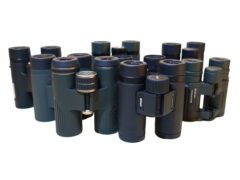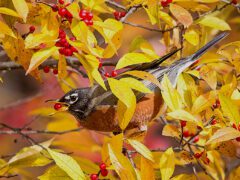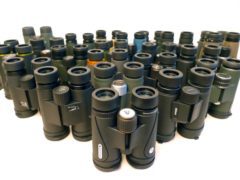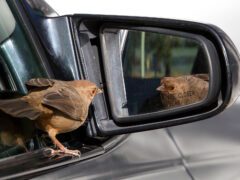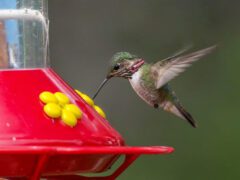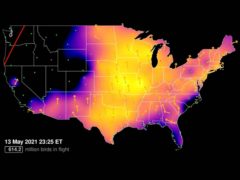The Four Keys to ID
- Size & Shape
Evening Grosbeaks are large, heavyset finches with very thick, powerful, conical bills. They have a thick neck, full chest, and relatively short tail.
Relative Size
About the size of a Northern Cardinal, but more compact and thicker bodied; smaller than a Steller’s Jay or Blue Jay.

 robin-sized
robin-sizedMeasurements
- Both Sexes
- Length: 6.3-7.1 in (16-18 cm)
- Weight: 1.9-2.6 oz (53-74 g)
- Wingspan: 11.8-14.2 in (30-36 cm)
© Alix d'Entremont / Macaulay Library
- Color Pattern
Adult male Evening Grosbeaks are yellow and black birds with a prominent white patch in the wings. They have dark heads with a bright-yellow stripe over the eye. Females and immatures are mostly gray, with white-and-black wings and a greenish-yellow tinge to the neck and flanks. The bill is pale ivory during the nonbreeding season and becomes greenish by late March.
© thomas berriman / Macaulay Library - Behavior
These are social birds that are often found in flocks, particularly in winter. They forage in treetops for insect larvae during the summer, buds in spring, and seeds, berries, and small fruits in winter.
- Habitat
They make very erratic movements south into the continental United States in some winters, when they can become common at backyard feeders. Away from backyards, they winter in forests and feed in both deciduous and coniferous trees, often at higher elevations. They breed in spruce-fir, pine-oak, pinyon-juniper, and aspen forests of northern North America and the mountains of the West.
© Jenn Megyesi / Macaulay Library
Regional Differences
There is little geographic variation in plumage, but Evening Grosbeaks do consist of at least three distinct populations, each with distinct call notes.
















